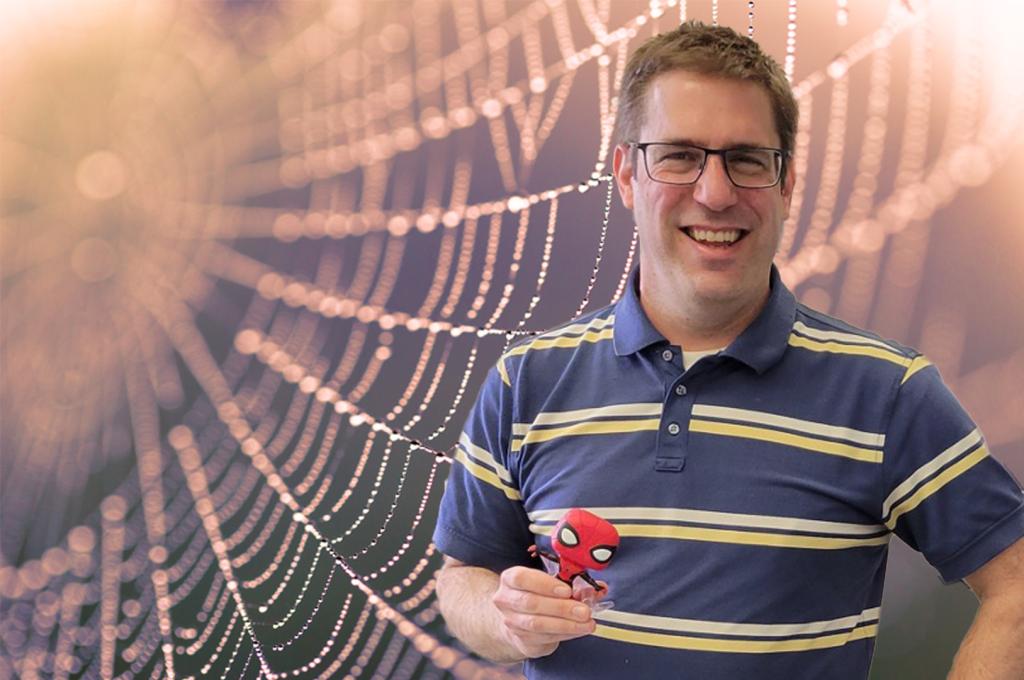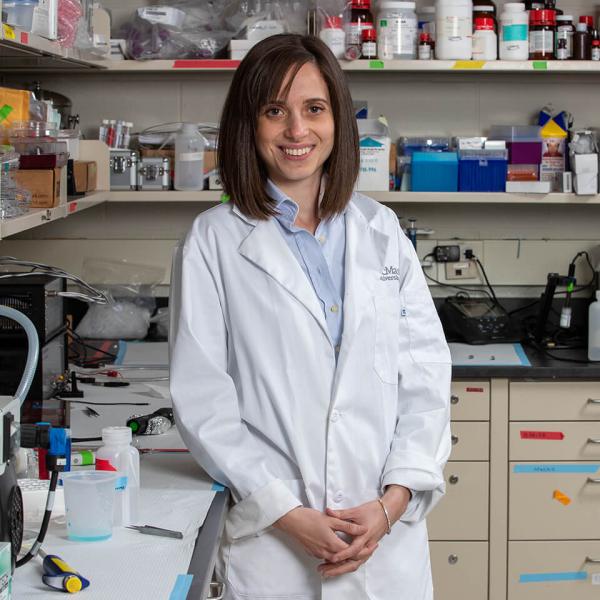HOST:
Hello, this is Greg Pilsworth, and I’m one of the producers of the podcast 10,000 ways.
For this episode, I wanted to ask some of my colleagues what they thought when they heard the word “spider.”
(Music in)
GUEST 01:
Eight legs.
Marvel movies.
I’m bigger than them.
HOST:
And there’s nothing comical about spiders for another colleague.
GUEST 02:
I am terrified of spiders.
I don’t know. I just can’t look at a spider without getting freaked out.
HOST:
One of my colleagues wasn’t too trusting.
GUEST 03:
They’re sneaky and ... they come up on you when you least expect it.
HOST:
Then we started to move towards acceptance.
GUEST 04:
I’m actually okay with them, and I quite like the fact that they eat other bugs.
HOST:
And then we got to the core of this podcast.
GUEST 05:
Spiders weave webs with materials that have more tensile strength than a lot of the things we make as humans.
HOST:
For this episode, we’re going to spend some time with a researcher who wants to learn all that he can about the seven silks of the orb weaver spider.
JAN RAINEY:
My name is Jan Rainey. I’m a professor in biochemistry and molecular biology at Dalhousie University in Halifax, Nova Scotia.
(Music out)
HOST:
We started out by telling Jan to pretend that he was at a “bring your dad to school day,” and he should explain to a classroom of grade 8s what he’s working on with spiders.
JAN RAINEY:
You may or may not know that spiders are able to make several different types of silk, and that includes the dragline that a spider hangs from, but also other materials such as the ones they use to wrap their prey.
So, each of these materials is fine-tuned for different properties. So, whether it be strong and not elastic, if you’re dangling from a thread, you don’t want to bounce around. But if you wrap prey, you don’t want that prey to encounter something too brittle, so it would just snap. So, what we’re really trying to understand is what are the features of these materials that allow them to behave so differently, even though they’re all being produced in the same organism, and then we can begin to apply that for purposes that a spider would never dream of.
HOST:
As an undergraduate, Jan had already found his passion for fibre, in part thanks to a co-op at the DuPont research centre in Kingston, Ontario. DuPont is known for products like Kevlar®, used in bulletproof vests, and the stretchy fabric LYCRA® which was created in the ’50s to replace rubber in clothing.
JAN RAINEY:
Spider silk is renowned for being able to absorb energy. So, that is a parameter called toughness in the materials world, and spider silk, depending how you do the math, you could say it’s the toughest known material per unit mass.
So, in other words, if you were able to make a bulletproof vest or something out of spider silk, instead of out of Kevlar, theoretically you should be able to produce something that weighs a lot less but is still able to absorb the same amount of energy.
While I was working on nylon, I also heard these very cool stories about the amazing properties of spider silks and, you know, to me it kind of tweaked my interest that a company like DuPont also might have an interest in these natural materials, as well as the synthetics that they had such a long history in producing and researching.
HOST:
Jan’s interest in spider silk remained on the back burner for a number of years following his time spent at DuPont, but it was rekindled again when one of his colleagues at Dalhousie, Paul Liu, shared his work on bacterial production methods.
JAN RAINEY:
One of my colleagues was working on producing spiders silks using bacterial production methods. He asked me if I’d be interested in adding a spider silk arm to our research program, so to speak, and I said, all that sounds like a great idea. It might be a bit challenging, but it sounds like fun, so let’s give it a shot.
HOST:
While Jan was very sure about his study of fibres, he wasn’t sure about the academic direction he should pursue.
(Music in)
JAN RAINEY:
As an undergrad student, I wasn’t really sure what I wanted to do, which I think it’s pretty common, and actually, it really was those work terms at DuPont that made me realize that research was a career and something I could think about, and that kind of solidified my thinking away from something like vet medicine or human medicine and towards a research focus.
And then I had the opportunity to do some more academically oriented research and do a little bit of teaching on the side, and that made me realize, wow, I could be a faculty member and have the best of both worlds here, where I can do some research, but also have the opportunity to teach and interact with students.
(Music out)
HOST:
When Jan isn’t teaching, he’s studying the physical, chemical and biological properties of spider silks. This includes a single silk produced by the Mesothelae spider or the dry adhesive silk produced by cribellate spiders or the prey wrapping silk and junction-forming pyriform silks produced by two different types of orb weavers.
JAN RAINEY:
A female orb weaver will make seven different types of silk, and to date, really only two of those have been extensively studied, so that leaves five other orb weaving spider silks that are not well understood, and then as we start to look across the breadth of spider species that are out there, there are some other smaller families of spiders that one family diverged a couple hundred million years ago and still only produces a single type of silk, for example, and yet has been able to persist in nature.
So, the question would be, what makes that silk sufficient for that spider to survive? Other spiders use a dry adhesive kind of material on their webs in order to capture prey through almost frictional forces. So, you could think of it as molecular VELCRO® or something, and so again, the question would be what makes that silk different from all of the others?
HOST:
One of these unique silks is designed to create anchor points on rocks or bricks or plants, and then another one of these silks, which attach to these anchor points is major ampullate silk, and it’s used to create the radial threads and the frame of a web.
(SFX in)
JAN RAINEY:
If you see a spider dangling from a thread, that would be dragline silk. It will also use that same silk as the main support for its web. So, that’s a material that’s very strong but not as elastic as some of the other silks, and then it will use a variety of other silk types in order to form sticky capture threads on its web or other stronger support threads going across the web, and so that would allow them to capture prey. Once the prey is stuck to the web, then it needs to be able to restrain it, so then it will use yet another type of silk to wrap the prey, and that would be called either wrapping silk or the aciniform silk, and that’s one of the main types of silk we study, actually.
HOST:
And just to briefly interrupt, tensile strength means strong and stretchy, and this is the characteristic of the silk used to wrap prey.
JAN RAINEY:
Actually, if it’s a female, it will use that same silk as an inner lining for its egg casing. So, it will produce wrapping silk around the egg, and then it has a separate type of silk that is used then as more of a shell for the egg.
So, I think we’re up to, you know, five or six different types of silk at this point, and then the other question is, if you’re a spider, how do you attach your web to a rock wall or to a brick or something? And so there’s actually another specialized type of silk that is used in that purpose and you can almost think of it as a fibreglass or something like that, where you have a series of fibres that are embedded and something kind of squishy, and what it, what that material is, is it’s a gluey substance that actually has tiny silk fibres in it, and this is yet another type of silk called pyriform silk, and those kind of act as a strong support in order to make sure that this gluey substance doesn’t just dissipate, and they attach directly to the dragline silk to provide an anchor for the web on dramatically different types of surface.
(SFX out)
HOST:
While the future looks promising for lab-generated synthetic silk, modelled in part on the silks created by orb weaver spiders, spider silk actually has a very interesting and long history, having previously been used for sutures, which are tiny pieces of thread used to sew up wounds.
JAN RAINEY:
People would harvest spider silk and then use this as a suture material, and why that’s important or useful to know is the fact that that implies that the material tends to be tolerated by humans and doesn’t necessarily produce an adverse reaction. We have a long history of these materials being recognized as being biocompatible for use in humans.
Now, of course, from the other side of the coin, if we want to begin to customize the material or even harvest significant quantities of the material, spiders are notoriously challenging to work with from any kind of agricultural consideration, in that they’re cannibalistic and territorial, and also, harvesting a lot of spider silk that is consistent in its properties is, it can be a big challenge.
HOST:
Just to be clear, naturally created spider silk is difficult to use because of inconsistencies in the composition or mechanical performance of fibres, but even more limiting is the fact that when a male spider jumps onto a female spider’s web, it’s like a cage match, and typically it’s only the female who will leave.
(Music in)
JAN RAINEY:
The other alternative then is to begin to produce these materials in the lab or in an industrial context, and we would typically use a non-pathogenic bacteria to do that. And why is that beneficial? Well, that’s beneficial because it allows us to customize the protein. So, we’re not stuck with the particular silk that the spider is making, but we can potentially combine different types of silk together, or we can begin to add human protein elements to those spider silks and then decorate the surface of a material that behaves like a silk with something that has a human sort of medical functionality.
And we’ve begun to explore that with one particular protein that, for example, and so we’re able to form a transparent silk film that binds, that holds these nerve growth factors on its surface, and then that enhances and supports cell growth, but also the nerve-like behaviour of cells that are growing on that surface.
Another area that we’re working on is similar to our approach where we figured out a way to sequester or bind nerve growth factor to silk. What we’ve done is we designed a silk that has a bioactive peptide or a hormone that’s attached to one end of the silk molecule and what that means is then we can create a silk film or fibre that now has a human hormone attached to it, and there have been some clinical trials and other studies that have looked at different ways of getting this hormone into the site of a myocardial infarction or heart attack, in order to improve functioning of the muscle after that takes place.
(Music out)
HOST:
So, it’s not hard to perceive the incredible potential spider silk has in helping with nerve regeneration or heart regeneration, but once again, it comes down to how can you make enough of the stuff for it to be practically useful. For Jan’s research, it began with something that might be called, “dip and draw.”
JAN RAINEY:
When we started the work, we were doing a technique which is called hand drawing. So, as the name implies, take a droplet of our protein solution and dip something sharp into that and then you can pull a fibre out of it.
HOST:
Jan estimates that it would take eight months of hand drawing, on a daily basis, to produce approximately 30 milligrams of “usable” fibre, and just for reference, a kernel of corn weighs about 300 milligrams.
JAN RAINEY:
We decided to work on an automated system to produce their fibres.
I had an outstanding graduate student at the time that developed an automated spinning approach. So, we had to find a solvent that would allow our protein to form a clear solution, so it would be distributed throughout the liquid at a high concentration, and spiders have fine-tuned this in their glands. They definitely want a situation where you have a protein that’s occupying most of the space in the gland, but they don’t want it to be prematurely gumming up the works, so to speak. So, you don’t want to be trying to capture a prey and not be able to shoot your web out or pull your web out more accurately, or if you’re dangling down on a thread, you don’t want it to suddenly stop and then the bird comes in and grabs you.
HOST:
The fibres used by the orb weaver spider to generate their webs have many attractive characteristics for researchers, but one thing we haven’t talked about is how big actually are their threads, these fibres, and for scale, let’s say we compare them to a strand of hair.
JAN RAINEY:
So, when we make them in the lab through our wet spinning automated process, then they would typically be on the order of maybe a fifth of a human hair or something along those, or along that size scale. But if you were to isolate natural spider silks, then depending on the application that the spider’s using them for, they might be something from a tiny fraction of the human hair up to approaching a human hair’s width. So, depending on the type of silk and what the spider’s using it for, it will produce dramatically different diameters of fibre.
HOST:
Producing synthetic spider silk at scale isn’t just a problem for Jan’s lab.
JAN RAINEY:
A big challenge in the spider silk field as a whole is being able to produce enough of the material that we can actually do something with it beyond the lab scale. But looking around the world, there’s a group in Sweden, for example, that recently reported enormous yields of their spider silk in an academic context. So, even in comparison to five years ago, when it was said that it would not be commercially feasible to produce a spider silk, suddenly we’re seeing these technologies begin to develop from a wide variety of sources around the world, which tells you that there should be many different approaches to overcome those problems.
HOST:
Five years ago, it was impossible to believe that sufficient quantities of synthetic fibre could be generated in a lab but now, as Jan mentions, there are companies around the globe who are starting to move in this direction, and in actual fact, one of those companies is Canadian.
JAN RAINEY:
Maybe a good example is our local company 3D BioFibR that I’m collaborating with, where they’ve developed a quite different method of producing protein-based fibres, and so this would be a way that we could dramatically increase the throughput of fibre production, and that gives a lot of opportunity then for academic-industrial collaboration, in that there’s no other straightforward way for a company like that to access enough spider silk that they could work with and for us, then it wouldn’t be easy for us to start to create a new production methodology of that sort.
HOST:
Generating new production methodologies, traditionally, have been time consuming and labour intensive, but AI may have the potential to speed up their development.
JAN RAINEY:
With AI tools, we can start to ask questions like, “What are the features of spider silk that might be universal, versus the features that might be more indicative of the ability of a spider to survive in an exceptionally humid environment, like a rainforest, versus in a desert?” And ideally, we’d be able to take advantage of those features and of the learning through an AI model to be able to start to design and engineer entirely new types of silk-based materials that function in an environment of our choosing.
HOST:
While cutting edge tools can help push research forward all the tools in the world won't necessarily provide a clear path to a perceived or intended destination.
(Music in)
JAN RAINEY:
When I started my lab here at Dalhousie, I had one main project that I thought was going to be the sure-fire project and that would be a guarantee to provide me years of results. And so, we were going to produce collagen-like peptides and then purify them and make tailor-made materials with these, and what happened was the production was not a problem but getting them in a purified form became extremely difficult. So, I was really kind of banging my head against the desk saying, what am I going to do because my main project here is not working the way I envisioned that it would.
And actually, the graduate student that was primarily working on that, initially, I had said, “Well, would you like to try a bit of spider silk work on the side, just, you know, give you some different experience?” And then that ended up becoming the main focus of her PhD research because it worked so well, whereas my bread-and-butter project just ended up being so intractably difficult that that was not something we ended up pursuing after that first funding cycle of five years.
(Music out)
HOST:
Jan received funding from the CFI most recently in 2021, which helped facilitate his research and his ability to study protein engineering, and this includes the fibrous proteins that are the building blocks of the spider silk. This type of research also requires cutting-edge lab equipment, so that we can see that which can’t be seen by the human eye.
JAN RAINEY:
With the infrastructure that we’ve been able to get, that provides us the ability to comprehensively determine these types of atomic-level structures and to understand how they might change under different conditions. So, for example, if we take a spider silk protein and we start to subject it to increasing pressure, then that pressure change may cause it to change its shape and start to behave as it might in the gland or the duct of the spider as it moves from storage through to fibre.
So, with our infrastructure, then, that’s provided us those kinds of capabilities in house rather than always having to either run across campus or go across the country or outside of Nova Scotia. So, it’s been quite groundbreaking to be able to do that in the building next door instead of in another province or country.
HOST:
We began this podcast by asking various people what they thought of when they heard the word “spider,” and we presented the same question to Jan.
(Music in)
JAN RAINEY:
Well, good question. I think they’re a pretty fascinating organism. You know, certainly if one scuttles out from under a cabinet or something, it may freak you out. But yeah, I think I’ve been able to overcome that because of the beauty of the materials that they produce. We’re still trying to figure out even the most fundamental question of what happens to these proteins or how do they change as they go from the soluble state, either in the gland of the spider or in our spinning apparatus, through to an insoluble fibre. So, we know that this happens, and we know it’s very reproducible, and we have lots of clues about the process, but we still don’t know exactly what is going on.
(Music out)
HOST:
Jan has been nothing if not persistent in his study of fibres, and while spiders may not be to everyone’s liking, Jan is passionate about his study of spider silks and passion, for Jan, is the key to success.
JAN RAINEY:
I think the differences and properties have been relatively recently discovered, and that’s mostly just from curiosity-driven research where people say, “I wonder what makes, you know, why would a spider have seven different glands that each produced their own silk-like material? Why? Why has that persisted when it’s seemingly duplication of effort?”
(Music in)
So, I guess for me, what I love is that you really don’t know what you’re going to encounter on a day-to-day basis. So, every day can be quite different from a research standpoint. You know, the biggest thing to go away with is to work on something that you’re passionate about and that excites you and drives you on a daily basis, and I think without that passion and interest, it’s pretty hard to succeed.
HOST:
Ultimately, Jan wants to understand what makes each silk unique for each individual spider. He wants to study the less studied silks. He wants to discover how silks have evolved to help spiders survive and how these discoveries can be exploited to help humans survive.
So, what does Jan hear when he mentions the word, “spider?”
JAN RAINEY:
There’s a lot of Spider-Man jokes that come up. Maybe it’s not that far from fruition either, so we’ll see.
HOST:
10,000 ways is produced in the studios of the Canada Foundation for Innovation. The CFI is a non-profit corporation that invests in research infrastructure at Canadian universities, colleges, research hospitals and non-profit research institutions. If you’re curious to learn more about the CFI then please visit innovation dot ca. That’s innovation dot ca. My name is Greg Pilsworth. Thank you very much for listening. Bye bye.
(Music out)






